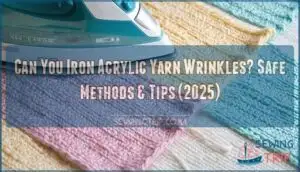This site is supported by our readers. We may earn a commission, at no cost to you, if you purchase through links.
 You can iron acrylic yarn wrinkles, but you’ll need to treat this synthetic material with kid gloves.
You can iron acrylic yarn wrinkles, but you’ll need to treat this synthetic material with kid gloves.
Set your iron to the lowest heat setting—acrylic melts faster than butter on hot pavement. Always use a pressing cloth between the iron and your project to prevent direct contact.
Never leave the iron in one spot, as acrylic fibers will turn into a gooey mess that’s beyond repair.
Steam works better than dry heat for most acrylic items. Test on a hidden area first to avoid turning your masterpiece into modern art.
The right technique makes all the difference between success and disaster.
Table Of Contents
- Key Takeaways
- Does Acrylic Wrinkle?
- How to Get Wrinkles Out of an Acrylic Sweater
- Can You Iron an Acrylic Sweater?
- What Temperature to Iron Acrylic
- Can You Iron Acrylic Yarn?
- Can You Steam Acrylic Yarn?
- Is Steam Blocking Acrylic Yarn Permanent?
- Can You Iron Acrylic Paint?
- What Happens if You Iron Acrylic Paint?
- Alternatives to Ironing Acrylic Yarn
- Frequently Asked Questions (FAQs)
- Conclusion
Key Takeaways
- You can iron acrylic yarn, but you’ll need to use the lowest heat setting (275-300°F) and always place a pressing cloth between the iron and your project to prevent the synthetic fibers from melting into a sticky mess.
- Don’t let your iron sit in one spot when working with acrylic fibers—keep it moving constantly since acrylic melts faster than natural fibers and direct contact will permanently damage your project.
- Steam works better than dry heat for removing acrylic yarn wrinkles, so consider using a handheld steamer held 6-8 inches away from the fabric or try steam blocking for permanent reshaping.
- Always test your method on a hidden area first, and if you’re unsure about ironing, stick with safer alternatives like gentle steaming, blocking with foam mats and pins, or using a damp pressing cloth.
Does Acrylic Wrinkle?
Acrylic yarn doesn’t wrinkle easily thanks to its synthetic composition, but it’s not completely immune.
Unlike cotton or wool, acrylic’s crease resistance comes from its plastic-based fibers that bounce back from minor folding. However, improper garment storage or heavy pressure can still create stubborn creases.
Smart storage beats stubborn creases—treat your acrylic right and watch those wrinkles surrender.
Acrylic blend wrinkles occur more frequently when mixed with natural fibers. To prevent wrinkles, hang your acrylic garments properly and avoid cramming them into tight spaces.
Understanding these wrinkle causes helps you maintain your projects’ smooth appearance with proper yarn care tips.
How to Get Wrinkles Out of an Acrylic Sweater
Getting your acrylic sweater wrinkle-free doesn’t have to be a headache. These gentle techniques will restore your favorite garment without damaging those delicate synthetic fibers.
Here’s your roadmap to perfect yarn wrinkle removal:
- Steam magic – Use a handheld steamer for quick, safe acrylic yarn wrinkles elimination
- Gentle washing – Add fabric softeners during the wash cycle for smoother results
- Smart drying techniques – Lay flat or hang immediately after washing
- Proper sweater storage – Fold carefully to prevent creasing between wears
- Wrinkle prevention – Store garments properly to minimize future issues
Steam beats ironing acrylic yarn every time for your acrylic sweater care.
Can You Iron an Acrylic Sweater?
You can iron an acrylic sweater, but proceed with caution.
Ironing acrylic? Yes, but tread carefully—one wrong move and your sweater becomes a melted mess.
Acrylic Ironing Risks include melting fibers and losing sweater shape retention.
Safe Ironing Methods require low heat settings and a pressing cloth barrier.
Never let the iron touch your acrylic sweater directly – this protects acrylic fiber integrity from heat damage prevention.
Steam settings work better than dry heat for yarn care tips.
When ironing acrylic yarn, keep the iron moving to avoid scorching.
Your acrylic yarn wrinkles will smooth out with gentle, indirect heat application.
Using steam settings can help in achieving the desired result without damaging the fibers.
What Temperature to Iron Acrylic
Temperature control makes the difference between success and disaster when ironing acrylic.
You’ll want to keep your iron between 275-300°F to avoid heat damage – think of it as the sweet spot where wrinkles disappear without melting your project.
To guarantee the best results, always check the garment label first.
Here’s your temperature roadmap:
- Set iron to synthetic or low polyester setting (270-290°F)
- Test on a small, hidden area first to check for melting point issues
- Use brief contact periods – don’t linger in one spot
- Keep the iron moving to distribute heat evenly
- Watch for glazing or fiber distortion as warning signs
Can You Iron Acrylic Yarn?
While possible, ironing acrylic yarn comes with significant risks you should know about. The synthetic material’s heat sensitivity means it can melt or deform at temperatures that seem safe for other fabrics.
Direct contact poses ironing risks that could permanently damage your projects. The melting point for acrylic sits dangerously close to standard iron settings, making temperature control critical.
Safe practices include using protective barriers and low heat, but even then, success isn’t guaranteed. For knit fabrics, steaming is gentler on delicate fibers.
Best alternatives like steaming often prove more reliable for removing acrylic yarn wrinkles.
Can You Steam Acrylic Yarn?
Steam blocking offers a gentler approach to smoothing acrylic yarn compared to direct ironing acrylic yarn methods. You can safely steam acrylic yarn by holding your steaming tool about one inch above the fabric surface. This technique prevents fiber damage while effectively removing acrylic yarn wrinkles.
Many crafters find a portable steaming device particularly helpful for this task.
Steam Blocking Benefits for your projects:
- Softens rough acrylic fibers without melting risk
- Improves yarn texture and overall project appearance
- Creates more manageable working conditions for crafters
- Provides uniform results across different Steaming Acrylic Blends
Remember these Steaming Safety Tips: never let steam directly contact the yarn, work in well-ventilated areas, and consider various Steaming Tool Options like handheld steamers or iron steam functions for ideal Post-Steaming Care results.
Is Steam Blocking Acrylic Yarn Permanent?
Unlike natural fibers that bounce back after washing, steam blocking creates permanent changes in acrylic yarn through heat shaping.
This process alters the fiber’s molecular structure, eliminating its original memory and creating lasting acrylic rigidity.
The blocking longevity means your projects maintain their shape through countless washes without reverting.
Many crafters find success using steam blocking products.
- Steam permanence transforms acrylic yarn permanently – once you apply controlled heat, those acrylic yarn wrinkles disappear forever, making steam blocking superior to temporary wet blocking methods for dimensional stability.
Can You Iron Acrylic Paint?
While acrylic paint can handle gentle heat, ironing acrylic paint requires careful technique to avoid disaster.
You’ll need to wait 24 hours for complete drying before applying any heat.
Mix your paint with fabric medium for better flexibility and canvas heat resistance.
Essential precautions for paint ironing effects:
- Never iron wet paint – you’ll create a sticky mess that ruins everything
- Use medium heat only – high temperatures destroy paint layer stability
- Always use a pressing cloth – direct contact melts your masterpiece
This approach guarantees sealing paint permanently while protecting your acrylic paint projects.
What Happens if You Iron Acrylic Paint?
Heat transforms acrylic paint into a nightmare you’ll want to avoid.
When you iron acrylic paint, temperatures above 320°F cause the paint melting point to trigger permanent damage.
You’ll witness disturbing color change effects as pigments break down, while surface adhesion impact destroys the bond between paint and canvas.
The fume toxicity risks become serious health concerns as heated paint releases dangerous VOCs.
Canvas damage potential increases dramatically with bubbling, cracking, and sticky deformation.
Acrylic paint ironing creates irreversible destruction that’ll ruin your artwork completely.
Alternatives to Ironing Acrylic Yarn
Since direct ironing can melt acrylic’s plastic fibers and leave sticky residue on your iron, you’ll want to explore safer methods that won’t damage your projects.
These gentle alternatives, including steaming, blocking, and using a pressing cloth, will smooth out wrinkles while preserving your yarn’s texture and integrity.
Steaming
Proper steaming transforms your wrinkled acrylic yarn projects without risking heat damage.
You’ll achieve professional results by maintaining the right steaming distance and controlling steam duration for effective acrylic rejuvenation.
- Steaming Distance: Hold your steamer 6-8 inches away from acrylic yarn to prevent melting
- Steamer Types: Use handheld garment steamers or iron steam functions for versatility
- Steam Duration: Apply gentle bursts for 10-15 seconds to prevent over-steaming damage
- Acrylic Rejuvenation: Let yarn cool completely between steam applications for ideal wrinkle removal
Blocking
Blocking offers a gentler path than steaming for reshaping your acrylic projects.
This technique uses foam mats, T-pins, and careful positioning to eliminate wrinkles while enhancing stitch definition.
Blocking benefits include smoother fabric surfaces and improved drape without heat damage risks.
You’ll need blocking tools like interlocking foam mats with grid markings and rust-proof pins.
Steam blocking proves most effective for acrylic yarn, creating permanent shape changes.
Blocking techniques work particularly well for sweaters, blankets, and decorative pieces requiring precise dimensions and professional-looking results, using blocking tools and interlocking foam mats to achieve the desired shape and appearance.
Using a Pressing Cloth
If steaming and blocking just won’t cut it for those stubborn wrinkles, reach for a pressing cloth before bringing out the iron.
This simple layer shields your creation during ironing acrylic yarn, soaking up excess heat transfer and preventing shine or melted patches.
Always stick with low to medium heat and let a damp cloth—cotton or linen works best—stand guard between the iron and your yarn.
This step keeps things cool, literally and figuratively, while avoiding residue and unwanted surprises, making it worth it to preserve your masterpiece.
- Imagine your favorite hat escaping disaster—just in time for winter!, and think about the importance of using a damp cloth to protect your project, ensuring you can avoid residue and keep your creation safe.
Frequently Asked Questions (FAQs)
Is it okay to iron acrylic yarn?
Think ironing acrylic’s risky? You’re absolutely right.
Direct contact will melt those plastic fibers faster than you can say "oops."
Use low heat with a pressing cloth, or better yet, try steaming from a safe distance instead.
Can acrylic yarn be straightened?
You can straighten acrylic yarn using steam blocking or gentle steaming from a distance.
Don’t use direct heat or traditional ironing – it’ll melt the synthetic fibers.
Steam reshapes the plastic composition safely.
How do you flatten acrylic yarn?
About 80% of crafters struggle with acrylic yarn’s stubborn creases.
You’ll flatten it best using steam blocking – hover your iron inches above the yarn, let steam work its magic, then pin flat overnight.
Will acrylic yarn melt with heat?
Yes, acrylic yarn will melt when exposed to high heat since it’s made from synthetic plastic fibers.
You’ll need to use low temperatures, around 290°F, with a pressing cloth to avoid permanent damage.
Does acrylic yarn shrink when heated or steamed?
Acrylic yarn won’t shrink when heated or steamed since it’s already pre-shrunk during manufacturing.
However, high heat can melt the synthetic fibers, causing permanent damage.
You’ll get deformation instead of shrinkage.
Can you use fabric softener on acrylic yarn?
Why wouldn’t you pamper your synthetic fibers?
You can absolutely use fabric softener on acrylic yarn.
It’ll reduce static, add softness, and help prevent wrinkles from forming during washing and drying cycles, which is a complete concept to consider for your synthetic fibers.
How long does steam blocking acrylic take to dry?
Steam-blocked acrylic typically dries overnight, taking 8-12 hours to fully set.
You’ll want to leave your project pinned and undisturbed during this time so the heat-shaped fibers can cool and hold their new form permanently.
Will ironing acrylic yarn damage my iron plate?
Direct contact between hot iron and acrylic yarn can melt the synthetic fibers, leaving sticky residue on your iron plate.
You’ll damage both the yarn and create a messy cleanup situation that’s tough to remove.
Can you wet block acrylic yarn projects effectively?
Why struggle with ineffective methods when you know better?
You can’t wet block acrylic yarn effectively since it’s plastic-based.
Water won’t reshape synthetic fibers permanently—you’ll need steam blocking for lasting results, as water won’t be enough.
Conclusion
Ready to tackle those stubborn creases? You can iron acrylic yarn wrinkles safely with proper technique and patience.
Keep your iron on low heat, use a pressing cloth, and never linger in one spot. Steam works better than direct heat for most projects.
When ironing isn’t ideal, try steaming, blocking, or using a damp cloth instead. Test your method on hidden areas first.
With these smart approaches, you’ll smooth out wrinkles without melting your beloved acrylic creations.
- https://www.reddit.com/r/crochet/comments/12f5j30/creases_how_do_i_get_the_crease_out_of_this_can_i/
- https://www.facebook.com/redheartyarns/posts/blocking-your-acrylic-projects-is-something-that-some-people-think-is-unnecessar/957971516365525/
- https://www.pinterest.com/pin/can-you-iron-acrylic-yarn-learn-the-safe-way-to-remove-wrinkles--864057878563123673/
- https://textile-yarn.com/blog/can-you-wash-acrylic-yarn/
- https://herrschners.com/how-to-block-acrylic-yarn?srsltid=AfmBOopqyVcco6x9t3sdVZiJ5Klmc2Kn_gQKK85UgTv2pOnffLoX_hrr













